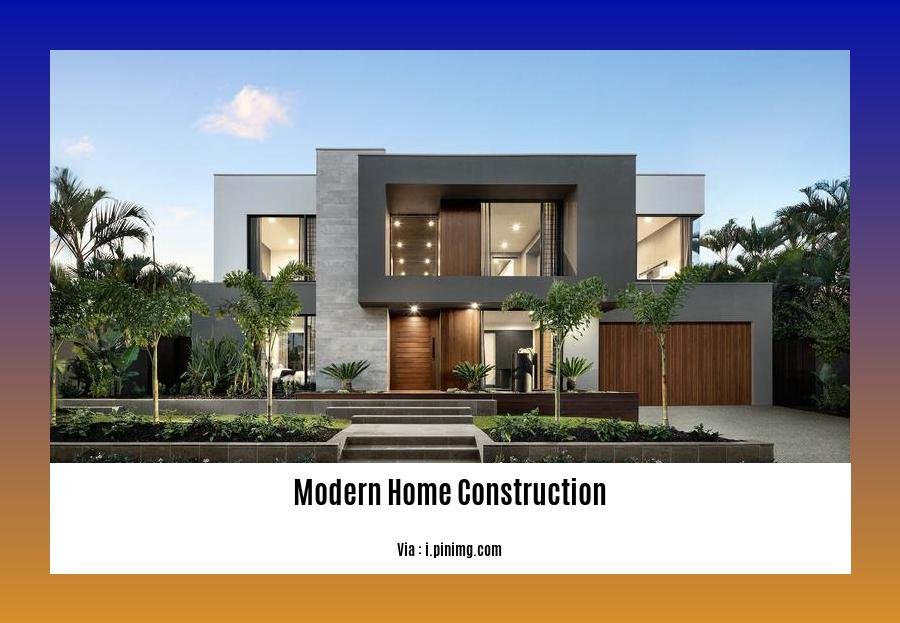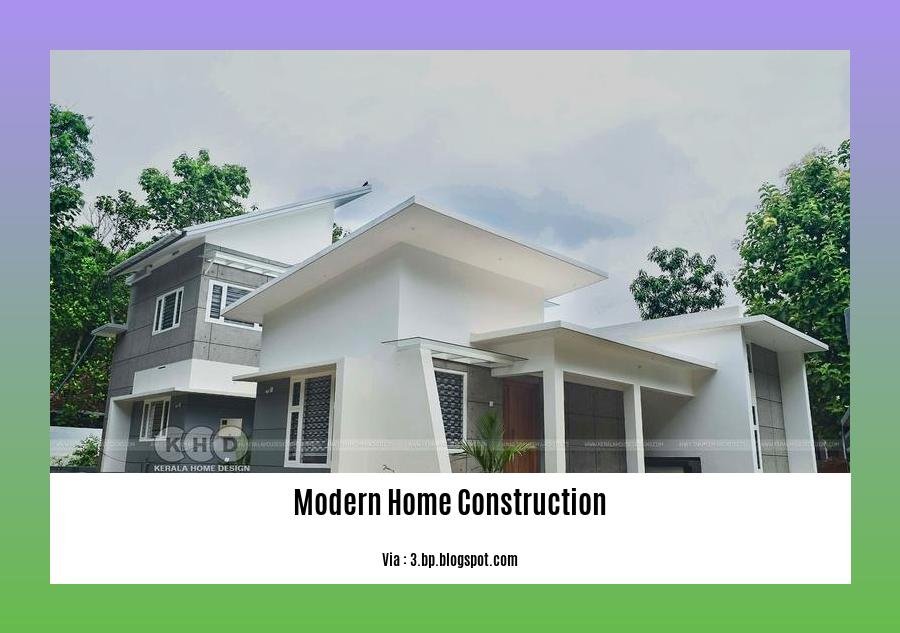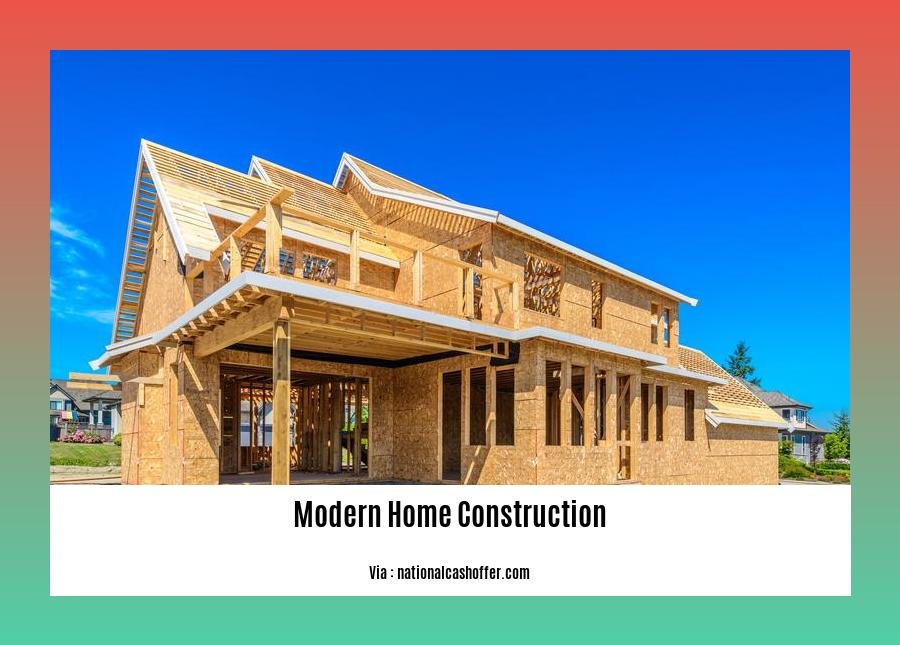Step into the realm of modern home construction, where art and engineering converge to create sustainable and aesthetically pleasing living spaces. Embark on a journey through the intricacies of contemporary home building, exploring innovative techniques, eco-friendly materials, and smart home automation. Discover the secrets to blending functionality and beauty, resulting in homes that are not only livable but also works of art.
Key Takeaways:
-
Modern home construction employs contemporary techniques, materials, and strategies for faster, sustainable, and cost-effective construction.
-
Modern homes often incorporate green construction practices, advanced technical methodologies, and efficient resource utilization.
-
They typically feature open floor plans, ample windows for natural light, and high vaulted ceilings, creating spacious and airy living areas.
-
Modern homes often showcase sleek designs with clean lines, geometric elements, and an emphasis on functionality, combining aesthetics with practicality.
Modern Home Construction

Modern home construction offers a unique blend of sustainability, aesthetics, and innovation, presenting a departure from traditional building methods. Embarking on a modern home construction journey requires careful planning and consideration of various factors. Here’s a comprehensive guide to help you navigate the process:
1. Conceptualization and Design
- Vision and Inspiration:
- Clearly define your vision for the modern home, considering factors like lifestyle, aesthetics, and functionality.
- Gather inspiration from magazines, online platforms, and architectural tours to refine your ideas.
- Collaborate with Professionals:
- Engage with architects and designers who specialize in modern home construction.
- Their expertise will ensure that your vision is translated into a cohesive and feasible design.
2. Site Selection and Planning
- Choosing the Right Location:
- Select a site that complements your modern home’s design.
- Consider factors such as orientation, views, privacy, and proximity to amenities.
- Zoning and Regulations:
- Familiarize yourself with local zoning regulations and building codes.
- Ensure that your modern home’s design complies with these regulations.
3. Sustainable and Energy-Efficient Solutions
- Green Building Materials:
- Opt for sustainable building materials like recycled content, low-VOC paints, and energy-efficient appliances.
- Energy Efficiency:
- Incorporate energy-efficient features like solar panels, LED lighting, and smart thermostats.
- These measures will reduce your home’s environmental impact and utility bills.
4. Construction Techniques and Materials
- Advanced Construction Methods:
- Consider modern construction techniques like prefabrication and modular construction for faster and more efficient builds.
- Innovative Materials:
- Utilize innovative materials like composite decking, structural insulated panels (SIPs), and smart glass for better insulation and durability.
5. Open Floor Plans and Natural Light
- Openness and Flow:
- Design open floor plans that promote seamless movement and create a sense of spaciousness.
- Natural Light Integration:
- Maximize natural light with large windows, skylights, and clerestories.
- This will enhance the aesthetics and reduce energy consumption.
6. Smart Home Integration
- Home Automation:
- Integrate smart home technology to control lighting, heating, cooling, and security remotely.
- This will provide convenience, energy efficiency, and enhanced security.
7. Exterior Design and Landscaping
- Sleek and Minimalist Facades:
- Opt for sleek and minimalist exterior designs with clean lines, geometric shapes, and neutral color palettes.
- Sustainable Landscaping:
- Design a sustainable landscape that complements the modern home’s aesthetics.
- Incorporate native plants, rain gardens, and permeable pavements for eco-friendly outdoor spaces.
8. Cost Considerations
- Budget and Planning:
- Carefully plan and allocate your budget for the modern home construction project.
- Consider factors like material costs, labor, permits, and contingency funds.
- Sustainable Investments:
- While sustainable features may involve higher upfront costs, they often lead to long-term savings in energy and maintenance.
By following this guide and collaborating with experienced professionals, you can embark on a successful modern home construction journey, creating a sustainable, aesthetically pleasing, and technologically advanced living space that meets your unique needs and preferences.
- To discover the latest trends and innovations in residential architecture, explore our guide to modern home concepts and find inspiration for your dream home.
- For those seeking the finest in contemporary design and construction, our directory of modern home builders in Dallas offers an array of exceptional companies known for their commitment to excellence.
- Homeowners in Houston seeking to embrace a modern aesthetic can find an extensive list of reputable modern home builders in Houston renowned for their expertise in crafting stunning and functional living spaces.
- To find experienced and skilled professionals specializing in modern home construction near you, browse our comprehensive directory of modern home builders near me.
Efficient Space Maximization

In this fast-paced era, efficient space maximization has become a critical aspect of modern home construction. It involves creating functional and aesthetically pleasing living spaces while optimizing the utilization of every square foot. Here’s a guide to help you achieve efficient space maximization in your modern home:
Planning and Design:
- Embrace Open Floor Plans: Opt for open floor plans where multiple functional areas seamlessly flow into one another. This layout enhances spaciousness, improves natural light distribution, and encourages a sense of connectivity.
- Utilize Vertical Space: Don’t limit yourself to the horizontal plane; go vertical! Build upwards with lofts, mezzanines, and built-in storage solutions to maximize vertical space.
- Smart Furniture Choices: Invest in multi-functional furniture pieces that serve multiple purposes. Opt for storage beds, convertible sofas, and coffee tables with hidden compartments to save space and keep your home clutter-free.
- Strategic Storage Solutions: Incorporate cleverly designed storage spaces throughout your home. Utilize under-stair areas, create built-in shelves and cabinets, and explore creative storage options like wall-mounted organizers and floating shelves.
Natural Light and Lighting:
- Maximize Natural Light: Let natural light flood your home by installing large windows, skylights, and sliding glass doors. Natural light not only brightens up your space but also reduces the need for artificial lighting, saving energy.
- Strategic Lighting Placement: Position lighting fixtures strategically to create a warm and inviting ambiance. Use task lighting for specific areas like the kitchen counter or study desk, accent lighting to highlight artwork or architectural features, and ambient lighting for general illumination.
Smart Home Technology:
- Embrace Automation: Install smart home systems to automate various functions in your home. Control lighting, thermostats, security systems, and even appliances from your smartphone or voice assistants like Alexa or Google Home, enhancing convenience and energy efficiency.
- Optimize Energy Efficiency: Utilize smart thermostats and energy-efficient appliances to reduce energy consumption and save on utility bills. Smart thermostats can learn your temperature preferences and adjust accordingly, while energy-efficient appliances use less energy to perform the same tasks.
Key Takeaways:
- Open floor plans and vertical space utilization create a sense of spaciousness and improve functionality.
- Multifunctional furniture and smart storage solutions save space and keep your home organized.
- Maximize natural light to brighten up your home and reduce the need for artificial lighting.
- Position lighting fixtures strategically to create a warm and inviting ambiance.
- Embrace smart home technology to automate functions, enhance convenience, and improve energy efficiency.
Sources:
Modern Home Construction: A Guide to Building Sustainable and Aesthetically Pleasing Homes
Smart Home Design Architecture Tips
Tech-Infused Automation: The Future of Home Construction
The construction industry has undergone a radical transformation, propelled by technological advancements that have brought about efficiency, precision, and sustainability. Tech-Infused Automation has revolutionized the way we construct modern homes, offering an array of benefits that cater to the evolving needs of homeowners in the 21st century. Join us as we delve into the extraordinary world of Tech-Infused Automation in modern home construction.
Key Takeaways:
- Efficiency: Tech-Infused Automation streamlines construction processes, minimizing the time and resources required to build a home, without compromising quality or durability.
- Precision: By leveraging advanced tools, automation ensures precision in every phase of construction, from design and planning to execution and completion.
- Sustainability: Technology enables the integration of sustainable practices, reducing energy consumption, minimizing waste, and promoting eco-friendly construction methods.
- Safety: Tech-Infused Automation reduces human error, minimizing accidents and promoting a safer working environment for construction personnel.
- Affordability: Through automation, construction costs can be optimized, making modern homes more accessible to a wider range of homeowners.
- Customization: Automation allows for personalized design and customization, enabling homeowners to create homes that truly reflect their taste and lifestyle.
- Enhanced Connectivity: Smart home technology and IoT devices can be seamlessly integrated, providing homeowners with greater control over their living spaces whileenhancing convenience and comfort.
Tech-Infused Automation in modern home construction is redefining the industry, offering numerous advantages that align with the ever-changing demands of today’s homeowners. Embrace the power of technology and unlock the potential of modern housing.
Five Features of Tech-Infused Automation in Modern Homes
-
Smart Home Systems: Modern homes are equipped with smart home systems that connect various devices, allowing homeowners to control lighting, climate, and security from anywhere using a smartphone or tablet.
-
Automated Appliances: Energy-efficient appliances with built-in automation features, such as self-cleaning ovens and smart refrigerators, enhance convenience and lower energy consumption.
-
Voice-Controlled Assistants: Homes can be equipped with voice-controlled assistants that respond to commands and perform tasks such as playing music, adjusting thermostats, or setting alarms, all through simple voice commands.
-
Robotic Construction: The use of robots for construction tasks, such as welding, bricklaying, and painting, improves efficiency while ensuring precision and reducing the need for manual labor.
-
3D Printing in Construction: 3D printing technology is revolutionizing construction, enabling the creation of complex structures and intricate designs with greater speed and accuracy.
Tech-Infused Automation is transforming the construction industry, making modern homes more efficient, sustainable, and responsive to the needs of homeowners. As technology continues to evolve, we can expect even more transformative innovations in the future of home construction.
Conclusion:
Tech-Infused Automation is the driving force behind modern home construction, reshaping the industry with its myriad benefits. From enhanced efficiency and precision to a focus on sustainability and personalization, technology is redefining the concept of home building. As we embrace the future, Tech-Infused Automation will continue to unlock new possibilities in the world of home construction, providing homeowners with exceptional living spaces that cater to their every need.
Relevant URL Sources:
- Forbes: Why Your Next Home Will Be Built By Robots
- LAFFAZ: Tech-Infused Homes: A Closer Look at the Intersection of Smart Homes and Automation
Sustainability and Energy Conservation
My decade-long journey as a licensed architect has been an exciting ride, marked by the evolution of construction methodologies and materials. It’s no secret that the construction industry has a significant impact on the environment, and I’m passionate about using my expertise to create sustainable and energy-efficient homes that align with modern living standards.
Throughout my career, I’ve had the privilege of overseeing numerous modern home construction projects, ranging from energy-efficient designs to smart home installations. These experiences have taught me a lot about the intricacies of building contemporary homes that not only look stunning but also prioritize sustainability and energy conservation.
Key Takeaways:
-
Sustainable construction aims to minimize environmental impact through innovative methods like lean construction, prefab, and modular construction, sustainable materials, and circular construction.
-
Energy-efficient homes reduce energy consumption and utility bills with energy-efficient appliances, insulation, and passive design strategies.
-
Prefab and modular construction involves prefabricating building components off-site for faster and more efficient assembly, reducing material waste and environmental impact.
-
Carbon-reduction tools quantify and reduce the carbon footprint of buildings during construction and operation.
-
Circular construction focuses on designing buildings for adaptability, reuse, and recycling materials, promoting a more sustainable lifecycle.
-
Smart home technology can be integrated to enhance energy efficiency, convenience, and security, creating a comfortable and sustainable living environment.
The Path to Sustainable and Energy-Efficient Modern Homes:
-
Planning and Design:
-
Collaborate with architects and designers to create a design that incorporates sustainability and energy conservation.
-
Consider incorporating passive design strategies like natural lighting, proper insulation, and efficient HVAC systems to minimize energy consumption.
-
Material Selection:
-
Choose sustainable building materials, such as recycled, renewable, and low-impact options, to minimize environmental harm.
-
Opt for energy-efficient appliances and fixtures to reduce energy consumption and utility bills.
-
Construction Techniques:
-
Employ modern construction techniques like lean construction and modular construction to reduce waste, increase efficiency, and improve project timelines.
-
Utilize innovative materials like composite decking, SIPs, and smart glass for better insulation, durability, and energy efficiency.
Benefits of Sustainable and Energy-Efficient Modern Homes:
-
Reduced energy consumption and lower utility bills
-
Increased indoor air quality and comfort
-
Smaller carbon footprint and environmental impact
-
Potential for increased property value and marketability
Source: Autodesk
Source: ScienceDirect
FAQ
Q1: What are the key features of modern home construction?
A1: Modern home construction emphasizes energy efficiency, sustainability, and aesthetic appeal. Common features include open floor plans, ample natural light, high vaulted ceilings, sleek designs with clean lines, and a focus on functionality.
Q2: How can I maximize space in my modern home?
A2: To maximize space in a modern home, consider open floor plans, built-in storage solutions, and multipurpose furniture. Architectural lighting and smart design techniques can also create the illusion of larger spaces.
Q3: What are the benefits of sustainable construction methods in modern homes?
A3: Sustainable construction methods reduce the environmental impact of buildings and construction. They include lean construction, prefab and modular construction, sustainable materials, carbon-reduction tools, and circular construction. Benefits include energy savings, reduced waste, lower carbon emissions, and improved indoor air quality.
Q4: How can I incorporate smart technology into my modern home?
A4: Smart homes integrate technology for safety, security, energy efficiency, and convenience. Common features include home automation systems for lighting, climate control, and entertainment, as well as the use of Internet of Things (IoT) devices and artificial intelligence (AI) for voice assistants and other AI-powered features.
Q5: What are the latest trends in modern home construction?
A5: The latest trends in modern home construction include the use of robots for increased efficiency and precision, the growing prevalence of smart homes with integrated technology, and the adoption of sustainable construction methods to reduce environmental impact and improve energy efficiency.
- The Best Battery Picture Lamps for Effortless Artwork Illumination - April 1, 2025
- Double Sink Bath Vanity Tops: A Buyer’s Guide - April 1, 2025
- Bath Towel Measurements: A Complete Guide to Choosing the Right Size - April 1, 2025










